What is Shoulder Separation or AC Joint Dislocation?
Acromioclavicular joint (AC joint) dislocation or shoulder separation is one of the most common injuries of the upper arm. It involves separation of the AC joint and injury to the ligaments that support the joint. The AC joint forms where the clavicle (collarbone) meets the shoulder blade (acromion).
What are the Causes of AC Joint Dislocation?
It commonly occurs in athletic young patients and results from a fall directly onto the point of the shoulder. A mild shoulder separation is said to have occurred when there is AC ligament sprain that does not displace the collarbone. In more serious injury, the AC ligament tears and the coracoclavicular (CC) ligament sprains or tears slightly causing misalignment in the collarbone. In the most severe shoulder separation injury, both the AC and CC ligaments get torn and the AC joint is completely out of its position.
Symptoms of AC Joint Dislocation
Symptoms of a separated shoulder may include shoulder pain, bruising or swelling, and limited shoulder movement.
How is AC Joint Dislocation Diagnosed?
The diagnosis of shoulder separation is made through a medical history, a physical exam, and an X-ray.
Treatment Options for AC Joint Dislocation
Conservative Treatment Options for AC Joint Dislocation
Low grade injuries to the AC joint can be successfully managed without surgery. Conservative treatment options include an initial period of rest, sling for comfort, cold packs, medications, and physiotherapy to gradually restore movement and function.
Surgical Treatment for AC Joint Dislocation
Surgery may be an option if pain persists or if you have a higher grade AC joint dislocation.
Anatomic Reconstruction of AC Joint Dislocation
Acute AC joint injuries can be surgically treated by anatomically reducing the AC joint and maintaining that position until the ligaments heal and stability is restored.
Traditional techniques require an open operation and fixation using a hookplate that requires a secondary operation usually 3 months later to remove the hookplate. Newer and more advanced techniques utilise arthroscopic and minimally invasive techniques to reduce the AC joint and maintain the reduction using ultra-high strength suture tapes that are passed through small bone tunnels and held together by small metal buttons (Arthrex Dog-Bone Technique). One of the main benefits of this less invasive technique is that no second operation is required to remove any hardware.
For more delayed and chronic cases of AC joint dislocation, anatomic reconstruction is required using a graft of your own tissue, such as a hamstring tendon to maximise the stability and healing of the AC joint. This technique is done through an arthroscopically assisted procedure. This surgery involves replacement of the torn CC ligaments by utilising your hamstring tendon. The graft tissue is placed around the location where the ligaments have torn and fixed using bio-compatible screws. The new ligaments gradually heal and help restore the normal anatomy of the shoulder.
Postoperative Rehabilitation for Shoulder Separation or AC Joint Dislocation Surgery
Postoperative rehabilitation includes use of shoulder sling for 6 weeks followed by which physiotherapy exercises should be done for minimum of 3 months. This helps restore movements and improve strength. You may return to sports only after 5-6 months after surgery.

